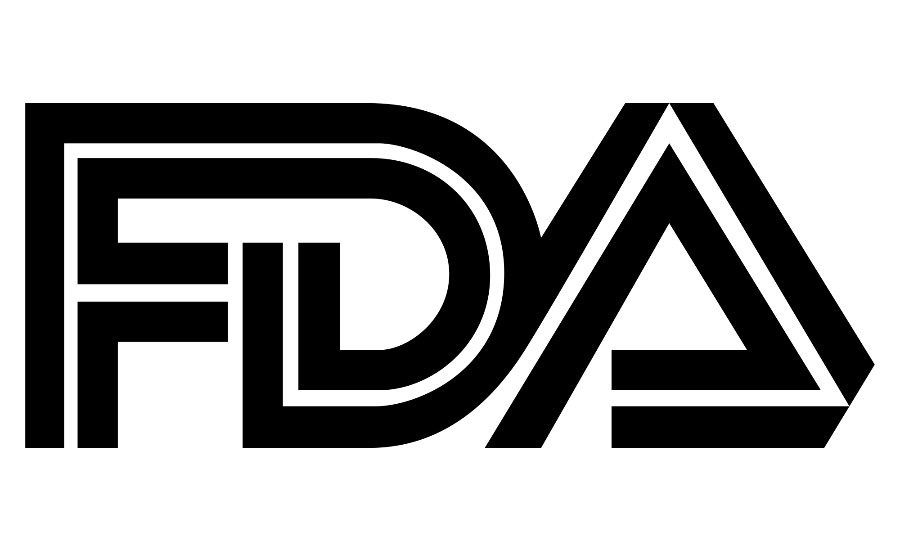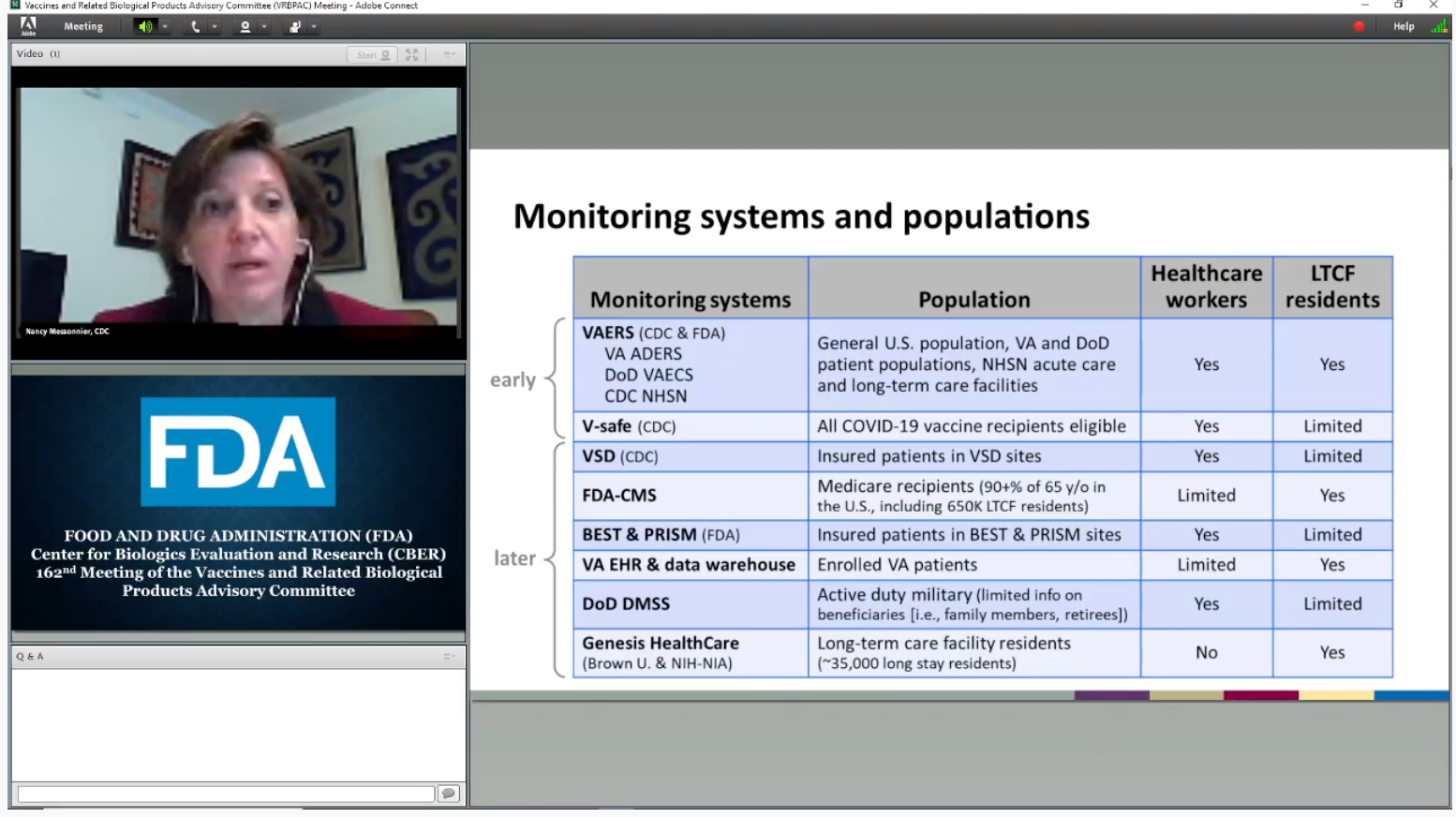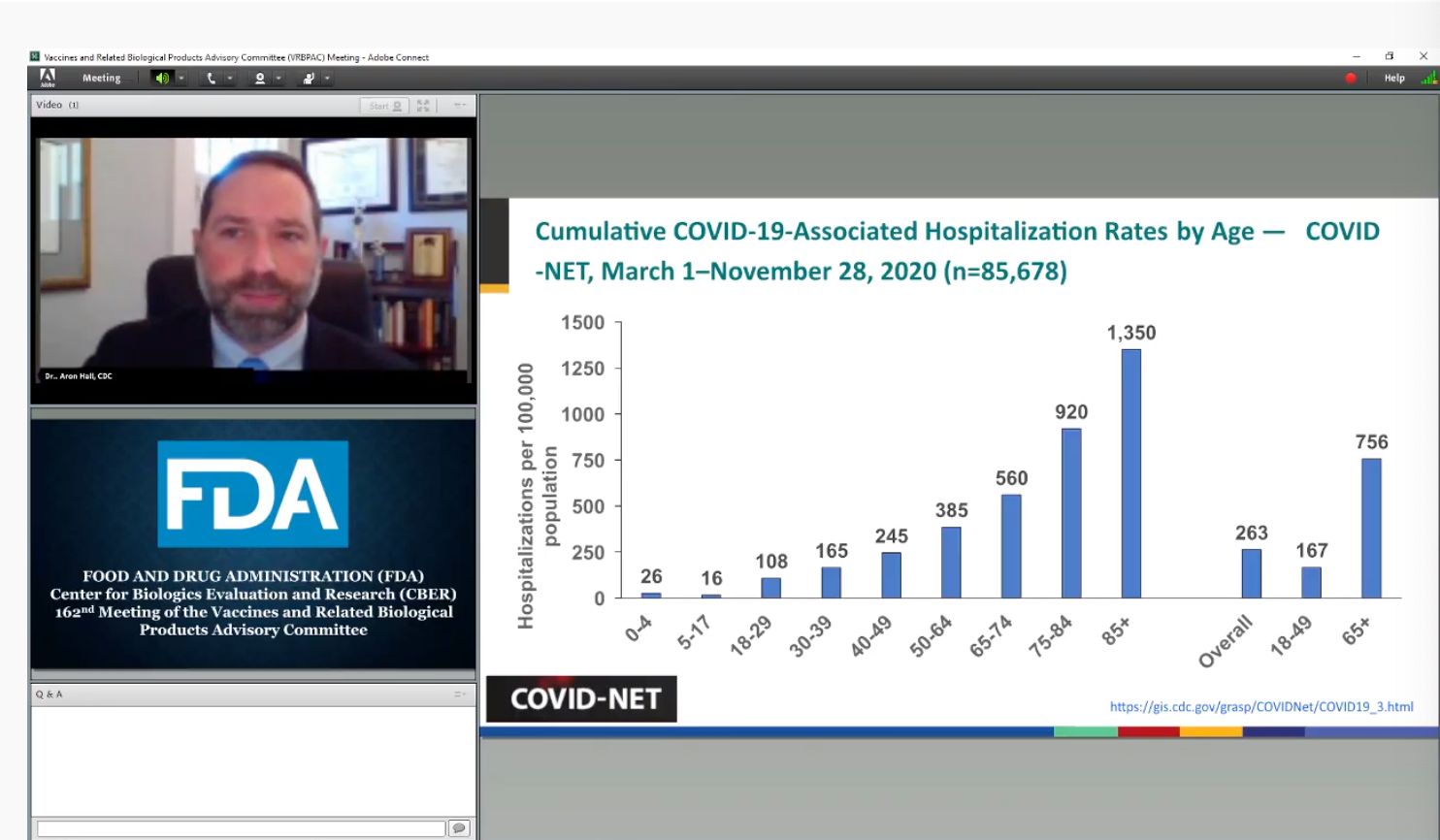FDA Advisory Committee Votes to Support Pfizer's COVID-19 Vaccine
The VRBPAC committee voted 17-4, with 1 abstention, to support the benefit-risk profile of BNT162b2 for preventing COVID-19 in persons aged 16 years and older.

5:37 PM Update: The Vaccines and Related Biological Products Advisory Committee (VRBPAC) has voted 17-4 with 1 abstention to support the benefit-risk profile associated with Pfizer-BioNTech COVID-19 vaccine BNT162b2.
The meeting adjourned immediately following the announced vote, without opportunity for committee members to discuss reasoning behind their vote—an uncommon practice in FDA advisory committee meetings.
The abrupt ending leaves questions as to why 4 experts voted against the vaccine's profile; however, the most pressing discussion leading into the vote pertained to limited information made available on trial participants aged 16 and 17 years old, as highlighted below.
The committee's supporting vote precludes a decision from the FDA on the Emergency Use Authorization (EUA) application from Pfizer, which would make BNT162b2 the first vaccine authorized to prevent COVID-19 in the US.
5:30 PM Update: Discussion over the VRBPAC committee vote question has headlined around the matter of age allowance pertaining to the EUA.
As some committee members stressed, given the poor representation of 16-17 year-old participants in assessment of BNT162b2, an EUA indicated for adults aged 18 years and older would be more ideal.
However, dissent to the suggestion also grew, as pediatricians and other experts emphasized the importance of beginning to vaccinate older adolescents despite substantial EUA data representation.
As one clinician stressed, including 16-17 year-old individuals in the emergency authorization would provide an ability to “climb down” age-level assessments to pediatric participants. If the hope is to eventually include a proven, regulated vaccine for COVID-19 prevention in the pediatric regimen of vaccines, this indication should remain the same.
Another expert stressed that such age groups are included in current “essential workforces,” and should be included in initial vaccination—especially given they are better represented than even some minority groups.
3:20 PM Update: In the FDA’s benefit-risk assessment of BNT162b2, they observed an overall benefit of reduced risk of COVID-19 at least 7 days following a two-dose vaccination regimen in individuals without prior history of SARS-CoV-2 infection.
They additionally assessed benefit consistent across subgroups stratified by age, race, gender, and comorbidity.
In observed risks, they noted the reported high rate of local and systemic adverse reactions, severe adverse events possibly associated with the vaccine including lymphadenopathy, limited data among observed adolescents 16-17 years old, and limited follow-up duration, plus risk assessment of pregnant women.
In response to Pfizer’s submitted pharmacovigilance plan in the event its EUA for BNT162b2 is accepted, the FDA has responded with already-accepted requests for details surrounding use in pregnant or lactating individuals, as well as in pediatric individuals aged younger than 16 years old.
The FDA additionally requested information on monitoring vaccine recipients for anaphylactic reaction risks, one day after a pair of UK vaccine recipients with a history of severe allergy reported nonfatal events after administration.
According to the FDA, adverse event reporting associated with the vaccine under the EUA would include coordinated data sharing and decision-making between the FDA and CDC via VAERS, which will receive data through 3 avenues:
- Voluntary reports from vaccine recipients
- Mandatory reports from vaccine providers
- Mandatory reports and monthly periodic safety reports from Pfizer
3:00 PM Update: Despite repeated interest in the prospect of single-dose efficacy with BNT162b2 for the prevention of COVID-19—given observed antibody development, reduced infection rates after first dose, and fewer unsolicited adverse events than with the second dose—FDA and Pfizer leadership emphasized during the advisory committee that such an indication is not currently being considered for authorization.
Simply put, whatever available data indicating potential immunity after the first dose of the mRNA is mitigated by shortened observation periods. Because nearly all Pfizer trial participants received their second dose in 3-4 weeks following the initial dose, investigators and regulator have far less long-term assessment of single-dose vaccination to weigh against the still-beneficial two-dose regimen.
2:30 PM Update: In their presentation of phase 2/3 outcomes submitted in accompaniment with their EUA application last month, Pfizer leadership addressed plans for long-term assessment of BNT162b2, and next steps in expanded studies.
William Gruber, MD, senior vice president of Vaccine Clinical R&D for Pfizer, shared intention for the company to complete its planned 24-month phase 2/3, randomized, placebo-controlled trial.
However, if the vaccine is granted EUA, they will inform current trial participants in the placebo arm of the vaccine’s availability. Such participants eligible for vaccination under the EUA criteria would hold the option to leave the trial to receive their doses.
At the same time, participants will hold the option to remain blinded to their vaccination status through the trial’s end—a factor which experts have stressed the importance of retaining throughout VRBPAC discussion today.
Pfizer additionally stated intention to expand BNT162b2 assessment into pediatric, pregnant, and immunocompromised participants, to observe it efficacy and safety in non-indicated populations.
The company also intends to share data regarding the vaccine’s benefit in reducing confirmed asymptomatic COVID-19 cases in 2021.
Gruber additionally stated the company is aware of the 2 allergy-based adverse events in vaccinated patients in the UK during BNT162b2 rollout this week, and will be monitoring dosed patients for similar outcomes.
1:15 PM Update: Public input during the VRBPAC meeting for Pfizer and BioNTech’s COVID-19 vaccine—from dozens of clinical experts, patient group advocates, and even a trial participant—reflected a positive reception to the reported profile of BNT162b2 for preventing COVID-19, albeit it with many calls for diligent monitoring and continued research going forward.
Diana Zuckerman, PhD, president of the non-profit National Center for Health Research, expressed concerns over the brief two-month median participant follow-up length set by the FDA in eligible EUA applications. Zuckerman additionally asked for better representation of patients to assure understanding of vaccine efficacy and safety in minority and older-age patients, calling a national report of the Pfizer’s efficacy in black participants based on extremely limited phase 2/3 data this week “extremely disturbing.”
Peter Doshi, PhD, of the University of Maryland School of Pharmacy, called on regulators to assure the study data included in the pending EUA was unblinded, that pain or fever relief therapy did not confound outcomes, and that severe COVID-19 prevention with the vaccine is accurate and contextualized.
Angela Rasmussen, PhD, of the Georgetown Center for Global Health Science and Security, said experts are “inherently limited” on information pertinent to BNT162b2’s long-term efficacy, safety, and immunity duration, and additionally faces limitations in assuring protection of older and minority populations.
She stressed serologic testing both prior to, shortly after, and annually following vaccination, to help establish baseline needs of prioritization and to interpret immunity duration with the two-dose vaccine.
Peter Lurie, MD, MPH, president of the Center for Science in the Public Interest, praised the presented “striking degree” of efficacy with the vaccine across participant subgroups. That said, few but notable unsolicited events in participants including Bell’s palsy warrant longer, scrutinized monitoring.
Most of all, Lurie stressed that the very high rate of solicited events among trial participants indicates the need for very transparent conversation on the vaccine’s effects between administrators and would-be recipients.
Evan Fein, a New York-based participant in the Pfizer-BioNTech phase 1 bnt162 clinical trial this summer, shared his experience of receiving a blinded trial dose in July.
Fein shared having mild fatigue with his first dose, then transient fatigue, fever, muscle pain, and chills following the second dose. The solicited events lead him to believe he received the vaccine rather than placebo.
He praised the trial’s investigators for following up on his condition frequently and with courtesy.
“Nothing felt rushed, and I never felt like a guinea pig,” Fein said.
Since receiving the dose, Fein said he has not been confirmed with COVID-19. He supported the immediate authorization of BNT162b2, echoing experts’ call for clear communication with the public.
“Most Americans will take the vaccine voluntarily, as long we’re honest, don’t talk down to them, and treated them like autonomous adults,” Fein said.
11:30 AM Update: The planned distribution and monitoring of the Pfizer COVID-19 vaccine, as per the CDC, will include product-dependent intricacies of cold storage, and will focus on observing long-term duration and secondary effects of the mRNA vaccine.
Distribution
During today’s VRBPAC meeting, Anita Patel PharmD, MS, Deputy of the CDC Vaccine Task Force, planned distribution of an emergency-authorized vaccine—which will be prioritized first for long-term care facility residents and healthcare workers—will adjusted situationally with the available volume of vaccines.
“As sufficient supply becomes available and the populations we’re trying to reach expands, our distribution network will further expand,” she said.
All authorized vaccines will be ordered via the CDC’s ordering system, with states each receiving a pro rata allocation of the Pfizer-BioNTech vaccine.
Administration sites for the vaccine will include pharmacies, hospitals, mobile vaccination units, and mass vaccination facilities.
Speaking specifically to the Pfizer product, BNT162b2 must be kept under -75 degrees Celsius throughout its supply chain. Doses, which will be shipped in quantities of no less than 195 vials, must be stored in ultra-low temperature freezers or up to 30 days in thermal shippers.
The thawed vaccine product must be used or disposed of within 6 hours, Patel said. The full vaccine administration course, as previously reported, is 2 doses split across 21 days.
Monitoring
Nancy Messonnier, MD, Director of the CDC National Center for Immunization and Respiratory Diseases, explained that COVID-19 vaccine post-EUA approval monitoring will entail active and passive surveillance of the prioritized vaccination groups, with case consultation being made to individuals.
Passive surveillance will be conducted by the CDC and FDA’s Vaccine Adverse Event Reporting System (VAERS), while case consults will be conducted by the CDC National Healthcare Safety Network (NHSN).
Active surveillance will be conducted via V-Safe, a new CDC program that monitors health status and events in vaccinated persons through texting and web notifications that allow persons to complete brief intermittent surveys through 12 months post-vaccination.
“We really need people to sign into this system to give us the best data available," Messonnier said.
Once COVID-19 vaccines are widely distributed, the US government will use large-linked database monitoring via the CDC and other agencies to observe for safety outcomes.
From the VRBPAC meeting.

For vaccine effectiveness, Messonnier said agencies will seek to address evidence gaps from phase 3 outcomes included in the EUA submission.
Namely, agencies will observe vaccine efficacy against SARS-CoV-2 infection and transmission—outcomes not currently available in any vaccine assessment—as well as the vaccine’s effectiveness for key patient subpopulations.
Additionally, over time, it will be vital to assess the duration of protection provided by vaccines.
The most immediate priority, Messonnier said, is answering the question, “Does the vaccine protect against symptomatic disease as expected?” Such an assessment will be undertaken in a prospective collection of outcomes in vaccinated healthcare workers versus control in the first 2-4 months of priority distribution.
10:40 AM Update: At the time of the VRBPAC meeting, the US has sent new records for daily new COVID-19 cases and related deaths.
In a presentation of current COVID-19 epidemiology during the advisory committee meeting, Aron J. Hall, DVM, MSPH, Epidemiology Task Force Co-Lead for the US Centers for Disease Control and Prevention (CDC) COVID-19 Response Team, reported that as of December 8, the US has reached 14.8 million confirmed cases, and more than 282,000 deaths.
“Since mid-September, daily counts of new cases have again been on the rise, with even sharper increases since mid-October,” he stressed.
While the FDA and its advisory committee weigh the benefit-risk profile of Pfizer and BioNTech’s BNT162b2 for the prevention of COVID-19, Hall’s report showed spiking rates of percent positive SARS-CoV-2 molecular tests and ambulatory visits for COVID-19 like illness across all age groups in the US—both metrics indicating national matters surrounding the pandemic are about to get worse.
Currently, weekly hospitalization rates are at the worse they’ve been since April, Hall said, largely driven by adults ≥65 years old.
In fact, approximately 1 in 133 adults aged ≥65 years old are hospitalized due to COVID-19 in the US.
From the VRBPAC meeting.

With the Advisory Committee for Immunization Practices (ACIP) announcing last week their recommended prioritization of healthcare workers and long-term care facility residents for the first doses of a COVID-19 vaccine,Hall depicted the burden the pandemic has put on both groups.
Currently, long-term care facility residents comprised more than half the hospitalized COVID-19 patients aged ≥75 years.
Additionally, 6% of all US adults hospitalized due to the virus have been healthcare workers.
Along with highlighting significant disparities in COVID-19 severity based on minority race and ethnicity—as well as comorbid cardiometabolic, pulmonary, or renal disease—Hall explained these numbers may actually be under-reported at the time of a pending vaccine.
CDC estimates for the number of cases relative to nationally-reported COVID-19 rates indicate SARS-CoV-2 infection may be 2.5 times greater in hospitalization cases, and 7.1 times greater in non-hospitalization cases.
That would put estimated hospitalizations at 2.4 million, estimated illnesses at 44.8 million, and estimated total infections at 52.9 million through just September.
9:50 AM Update: The FDA has found the manufacturing quality and consistency associated with BNT162b2 from Pfizer and BioNTech to be adequate for EUA approval.
In the presentation of FDA expectations for Emergency Use Authorization for a COVID-19 vaccine at the beginning of the advisory committee meeting, Doran Fink, MD, PhD, Deputy Director of the FDA Division of Vaccines and Related Products Applications (DVRPA), stated review of the companies’ manufacturing and distribution strategies included in its EUA was positive for authorization.
The comment is the first indication in the day-long meeting that the submitted EUA for the first possible US vaccine for COVID-19 is favorable to the FDA.
In Fink’s presentation, he established FDA expectations for a COVID-19 vaccine emergency authorization, which includes previously-shared standards for efficacy and safety data, as well as planned longterm research, and manufacturing quality and consistency.
Issuance of an EUA, Fink said, will specify the conditions of vaccine use—including its indicated patient population, conditions for distribution and administration, and requirements for safety monitoring and continued adverse event reporting.
Over the last month, the FDA has been reviewing Pfizer and BioNTech’s submitted application, including:
- Verification of clinical data integrity and Pfizer analyses, and additional FDA analyses from datasets included in submission.
- Ongoing review of chemistry, manufacturing and control information, non-clinical data, and clinical assays.
- Review and revision of prescribing information and fact sheets for vaccine recipients and healthcare providers.
- Multiple information requests to Pfizer over questions and clarifications regarding its data.
- Preparation for the VRBPAC meeting.
“The American public demands and deserves a rigorous, comprehensive and independent review of the data, and that’s what FDA physicians and scientists, all of us career public health servants, have been doing over days, nights, weekends, and even over the Thanksgiving holiday,” Fink said.
-----
8:40 AM Update: Today marks the first Vaccines and Related Biological Products Advisory Committee (VRBPAC) meeting from the US Food and Drug Administration (FDA) for the consideration of an Emergency Use Authorization (EUA) application for a coronavirus 2019 (COVID-19) vaccine candidate.
The independent panel of experts are hosting an agenda of sessions and open discussion surrounding BNT162b2, from Pfizer and BioNTech, prior to the FDA’s overall decision on the companies’ submitted EUA.
A supporting vote in favor of the submitted materials for the vaccine’s benefit of preventing COVID-19 would likely lead to the indication of BNT162b2 as the first vaccine approved to prevent the pandemic virus in the US.
This page will be updated throughout the day of Thursday, December 10, with details and perspectives shared during the VRBPAC meeting. Be sure to check back in, and follow Contagion® on Twitter.
For a review of the submitted phase 2/3 data for BNT162b2, as well as the VRBPAC’s meeting agenda, click here.
For a podcast discussion on the preliminary efficacy of the Pfizer-BioNTech vaccine, as well as its eventual distribution throughout the US, click here.
